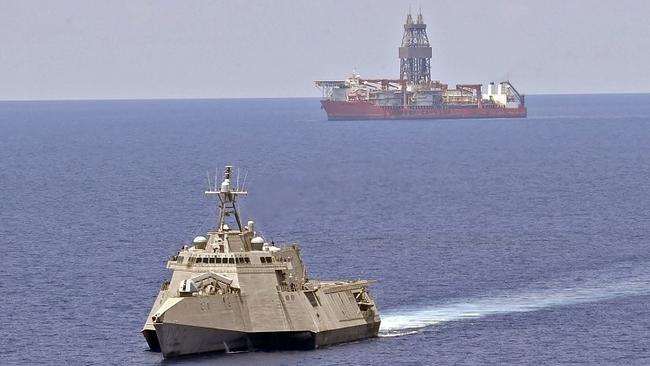US warships sent to bolster Malaysia in South China Sea
The US Navy has sent three ships to the South China Sea in a show of support for Malaysia against Chinese pressure.

The US has sent three naval ships on patrols near oil and gas operations off Malaysia’s coast this week, a show of support for the Southeast Asian nation whose offshore explorations in the South China Sea have faced pressure from China.
The littoral combat ship USS Gabrielle Giffords on Tuesday sailed close to the drillship West Capella, contracted by Malaysia’s national oil company, after two other US naval vessels patrolled there last week. The US Navy called these presence operations.
US officials have accused China of coercing smaller countries out of developing offshore resources. Officials said the operations show America’s commitment to the region and the US Navy’s capability.
The flurry of activity has included exercises in the South China Sea last month that involved three American warships and an Australian frigate. It comes at a time when a coronavirus outbreak aboard aircraft carrier USS Theodore Roosevelt has raised questions about the US’s military readiness, said Collin Koh, a research fellow at the S. Rajaratnam School of International Studies in Singapore.
Tensions intensified last month when a Chinese oil and gas survey ship arrived close to where the Malaysia-authorised West Capella was operating. Even before that, Chinese coastguard vessels had been patrolling around the drillship, maintaining an intimidating presence.
Chinese coastguard ships and fishing-militia ships escorted the Chinese survey vessel, which at one point was as close as 8.5 nautical miles from the West Capella. The survey vessel, Haiyang Dizhi 8, was no stranger to security officials in the region. Last year, it was at the centre of a months-long standoff with Vietnam over an offshore-drilling project that Hanoi had authorised and Beijing wanted stopped.
China claims nearly all of the South China Sea and objects to oil and gas operations that don’t involve Beijing. An international tribunal ruled in 2016 that its claims — which overlap with those of Vietnam, Malaysia, Brunei, Taiwan and The Philippines — have no legal basis. Beijing has rejected the ruling.
China’s Foreign Ministry said on Wednesday that its research vessel was “conducting normal activities in the oceanic area governed by China”. It urged the US, which it referred to as the “relevant country outside the area”, not to take actions that could further complicate the situation.
The West Capella left the area on Tuesday after completing its task. The Chinese survey ship remained in the area, data from maritime intelligence provider MarineTraffic showed.
For countries such as Vietnam and Malaysia, the presence of Chinese ships close to their energy projects creates the risk of an accidental collision and escalation of tensions with Beijing.
Ultimately, the operations sought to pressure Southeast Asian countries into developing offshore resources jointly with China, Mr Koh said. Beijing is pursuing such a deal with Manila.
The episode has added to tensions between the US and China, which have already surged over the pandemic. The commander of the US Pacific Fleet, Admiral John Aquilino, said last week: “The Chinese Communist Party must end its pattern of bullying Southeast Asians out of offshore oil, gas, and fisheries”. He echoed Secretary of State Mike Pompeo who last month accused Beijing of “exploiting the world’s focus on the COVID-19 crisis by continuing its provocative behaviour”.
All three types of the US Air Force’s long-range bombers — the B-2 Stealth, the B-52H Stratofortress and the B-1B Lancer — have been flying missions in the Indo-Pacific region in a co-ordinated show of force to demonstrate that the US is ready to confront any aggression, even amid the coronavirus crisis.
Last week two Chinese ships scared off a Japanese fishing boat in the waters around the Senkaku islands before the Japanese coastguard arrived and ordered the Chinese vessels to leave.
The Wall Street Journal



To join the conversation, please log in. Don't have an account? Register
Join the conversation, you are commenting as Logout